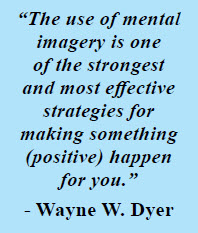 By: Lisa Philippart
By: Lisa Philippart
In my previous article, I shared a broad overview of what it looks like to work with therapeutic imagery to reduce distress by changing the toxic meaning of an image. Two of four imagery techniques will be addressed in this article: Imagery Manipulation and Imagery Rescripting.
Imagery manipulation is utilized to reduce the distress and “realness” of an image. Imagine putting the disturbing image on a screen (TV, computer, or movie.) Consider using your safe place as a base to watch…using an observer’s perspective. In other words, see yourself sitting and watching the uncomfortable image or event on the screen. With your imaginary remote controller, experiment with making the image smaller or more distant, turning it into black and white, removing the sound, or pausing the image. Try fast forwarding the image to a time when you feel safe again. Try adding or changing the soundtrack, fading in or out, or moving the image around, until your pain is tolerable. Imagine a plate or sheet of strong clear plastic as protection, and put it between your face and the screen. Take an observer’s perspective within the image…for example, as a bird looking down, or as someone else uninvolved with the incident.
 Another way to manipulate imagery is to change the elements of the image itself. For example, you can change the faces of the characters, making them look silly or powerless. Or you can change the characters’ expressions or body parts. For example, make someone weak with spindly arms, or with Mickey Mouse ears, or a Pinocchio nose. You can also change the size of the characters (the child or adult you) to look stronger and bad characters to look weaker. One goal of imagery manipulation is learning to see troubling images (mental events), rather than as reality. The second goal is to allow us to move closer to the image with compassion, allowing it into our awareness, rather than pushing it away and trying to avoid it. And lastly, imagery manipulation helps us to learn to use mindfulness (being fully present in the moment) with imagery, which can be used for any image, rather than only for traumatic images.
Another way to manipulate imagery is to change the elements of the image itself. For example, you can change the faces of the characters, making them look silly or powerless. Or you can change the characters’ expressions or body parts. For example, make someone weak with spindly arms, or with Mickey Mouse ears, or a Pinocchio nose. You can also change the size of the characters (the child or adult you) to look stronger and bad characters to look weaker. One goal of imagery manipulation is learning to see troubling images (mental events), rather than as reality. The second goal is to allow us to move closer to the image with compassion, allowing it into our awareness, rather than pushing it away and trying to avoid it. And lastly, imagery manipulation helps us to learn to use mindfulness (being fully present in the moment) with imagery, which can be used for any image, rather than only for traumatic images.
Imagery rescripting involves changing the memory (rescripting the image) by coming up with a more positive or acceptable outcome, which therefore reduces the distress and beliefs associated with the image. The mental imagery must be envisioned, so the scenario can be subsequently worked through with an awareness of how to respond at each stage, and if anything unexpected comes up. Some questions to ask yourself beforehand include: How can I now make sense of all this? What does this mean to me now? What does this say about me and about others? What would I like to have happen? What needs to happen in order to change the way I think and feel about it now? How do things look now from an adult perspective? If I could go back and speak to myself at that time, what would I say? Who could I bring in to help me?
 The best part of imagery rescripting is that there are numerous positive outcomes for a previously unsettling event. You can change the ending! You can enter the scenario as a healthy adult (particularly with childhood trauma) to help nurture, protect, or confront. You could bring in other characters (real or imagined) who are likely to be helpful…family members, respected friends, or imaginary superheroes. You might punish the perpetrator, by involving crime fighting agencies. And finally, you may bring in other objects that might change the outcome such as a cell phone, personal alarm, or pepper spray. I encourage you to use the present tense as you rewrite the imagery event. You have control over how this scenario plays out.
The best part of imagery rescripting is that there are numerous positive outcomes for a previously unsettling event. You can change the ending! You can enter the scenario as a healthy adult (particularly with childhood trauma) to help nurture, protect, or confront. You could bring in other characters (real or imagined) who are likely to be helpful…family members, respected friends, or imaginary superheroes. You might punish the perpetrator, by involving crime fighting agencies. And finally, you may bring in other objects that might change the outcome such as a cell phone, personal alarm, or pepper spray. I encourage you to use the present tense as you rewrite the imagery event. You have control over how this scenario plays out.
In my next article we will wrap up this series on working with imagery by discussing compassionate nurturing imagery and imagery rehearsal.
By: Lisa Philippart
Licensed Professional Counselor







